新职业英语视听说教案U112次
- 格式:doc
- 大小:26.50 KB
- 文档页数:4
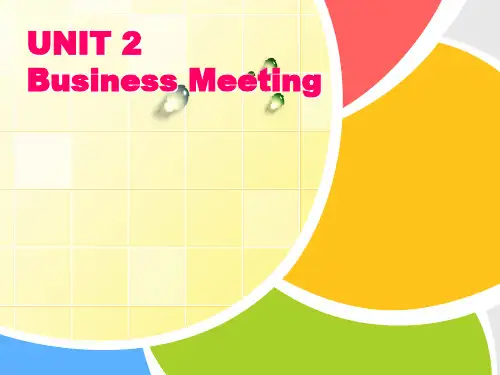
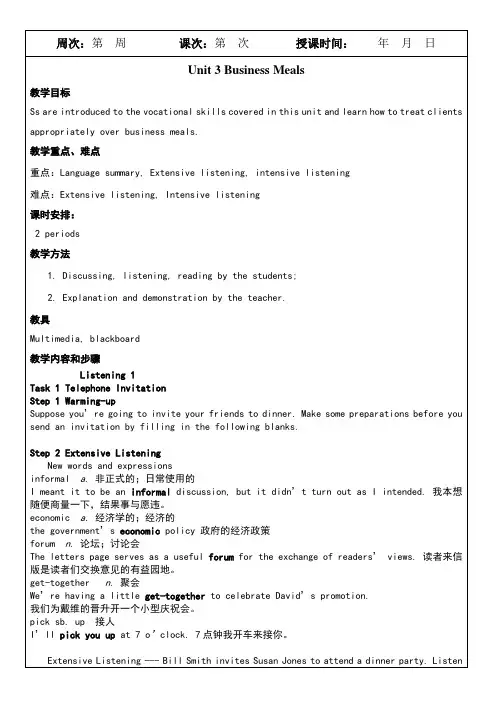
Unit 3 Business Meals教学目标Ss are introduced to the vocational skills covered in this unit and learn how to treat clients appropriately over business meals.教学重点、难点重点:Language summary, Extensive listening, intensive listening难点:Extensive listening, Intensive listening课时安排:2 periods教学方法1.Discussing, listening, reading by the students;2.Explanation and demonstration by the teacher.教具Multimedia, blackboard教学内容和步骤Listening 1Task 1 Telephone InvitationStep 1 Warming-upSuppose you’re going to invite your friends to dinner. Make some preparations before you send an invitation by filling in the following blanks.Step 2 Extensive ListeningNew words and expressionsinformal a.非正式的;日常使用的I meant it to be an informal discussion, but it didn’t turn out as I intended. 我本想随便商量一下,结果事与愿违。
economic a.经济学的;经济的the government’s economic policy 政府的经济政策forum n.论坛;讨论会The letters page serves as a useful forum for the exchange of readers’ views. 读者来信版是读者们交换意见的有益园地。
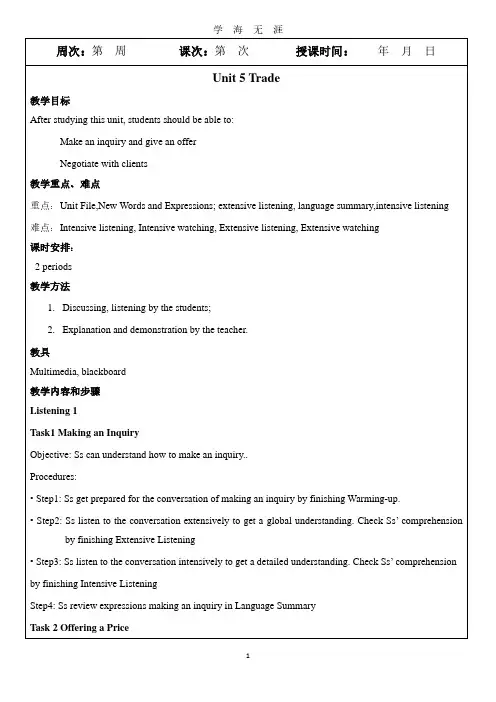
周次:第周课次:第次授课时间:年月日Unit 5 Trade教学目标After studying this unit, students should be able to:Make an inquiry and give an offerNegotiate with clients教学重点、难点重点:Unit File,New Words and Expressions; extensive listening, language summary,intensive listening难点:Intensive listening, Intensive watching, Extensive listening, Extensive watching课时安排:2 periods教学方法1.Discussing, listening by the students;2.Explanation and demonstration by the teacher.教具Multimedia, blackboard教学内容和步骤Listening 1Task1 Making an InquiryObjective: Ss can understand how to make an inquiry..Procedures:• S tep1: Ss get prepared for the conversation of making an inquiry by finishing Warming-up.• Step2: Ss listen to the conversation extensively to get a global understanding. Check Ss’ comprehension by finishing Extensive Listening• Step3: Ss listen to the conversation intensively to get a detailed understanding. Check Ss’ comprehension by finishing Intensive ListeningStep4: Ss review expressions making an inquiry in Language SummaryTask 2 Offering a PriceObjective: Ss can understand a description and explanation of offering a price.Procedures:• S tep1: Ss complete the complete spelling with your parter. Provide more related words.• Step2: Ss listen to a speech by Alice\Laurent White and tick the correct answer to each question • Step3: Ss listen to the conversation again and read the following sentences about offering a price. Watching 1Task 1 Negotiating a discountObjective:Ss can learn the skills of asking about and negotiating a discount.Procedures:• S tep1: Warming-upRead the following paragraph carefully and fill in the blanks with the given words.• Step2: Ss watch a video clip and answer to each question..• Step3: Ss watch a video clip again and decide if the following statement are T\F..• Step4: Ss review the sentences describing a price negotiation in Language Summary.课后作业:Finish the corresponding exercise课后小结:周次:第周课次:第次授课时间:年月日Unit 5 Trade教学目标After studying this unit, students should be able to:Sign a sales contractEffect a sales contract教学重点、难点重点:Warm-up activity, Language summary, Intensive watching, Extensive watching难点:Intensive watching, Extensive watching, Speaking课时安排:2 periods教学方法1. Discussing, listening, reading, presenting, and role-playing by the students;2. Explanation and demonstration by the teacher.教具Multimedia, blackboard教学内容和步骤Watching1Task 2 Signing the contractObjective:Ss can learn the skills of describing and explaining a contract..• S tep1: Warming-upSuppose you are to sign a sales contract, what should you do before signing your name in the contract? Work in pairs and list them.• Step2: Ss watch a video clip and tick those that are covered in the talk.• Step3: Ss watch a video clip again and answer the related questions..• Step4: Ss compare the words and expressions in Language Summary.Speaking 1Objective: This part aims at guiding Ss to practice the skills they’ve learned in Listening1 and Watching 1. • Step1: Ss work in pairs. Complete and practice conversation.• Step2: Ss work in pairs. Role-play a conversation.• Step3: Ss work in pairs. Make sentences with the help of the tips.• Step4: Ss work in pairs. Suppose you are going to sign a contract. One act as a sales representative and the other acts as a client.Listening 2Task1 Preparing the OrderObjective: Ss can understand a description of preparing the Order.Procedures:• S tep1: Ss learn some brainstorm for preparing the order by finishing Warming-up.• Step2: Ss listen to the conversation and answer the following questions.• Step3: Ss listen to the conversation intensively and fill in the blanks with proper words.Step4: Ss translate the following sentences into Chinese.课后作业:Finish the corresponding exercise课后小结:。
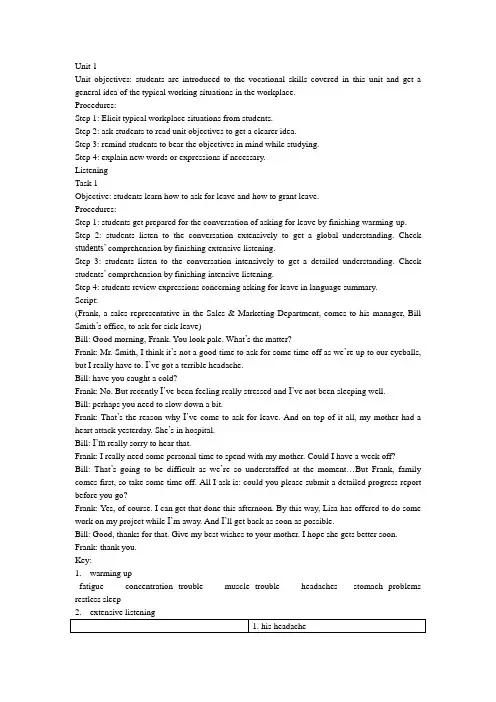
Unit 1Unit objectives: students are introduced to the vocational skills covered in this unit and get a general idea of the typical working situations in the workplace.Procedures:Step 1: Elicit typical workplace situations from students.Step 2: ask students to read unit objectives to get a clearer idea.Step 3: remind students to bear the objectives in mind while studying.Step 4: explain new words or expressions if necessary.ListeningTask 1Objective: students learn how to ask for leave and how to grant leave.Procedures:Step 1: students get prepared for the conversation of asking for leave by finishing warming-up. Step 2: students listen to the conversation extensively to get a global understanding. Check students’ comprehension by finishing extensive listening.Step 3: students listen to the conversation intensively to get a detailed understanding. Check students’ comprehension by finishing intensive listening.Step 4: students review expressions concerning asking for leave in language summary.Script:(Frank, a sales representative in the Sales & Marketing Department, comes to his manager, Bill Smith’s office, to ask for sick leave)Bill: Good morning, Frank. You look pale. What’s the matter?Frank: Mr. Smith, I think it’s not a good time to ask for some time off as we’re up to our eyeballs, but I really have to. I’ve got a terrible headache.Bill: have you caught a cold?Frank: No. But recently I’ve been feeling really stressed and I’ve not been sleeping well.Bill: perhaps you need to slow down a bit.Frank: That’s the reason why I’ve come to ask for leave. And on top of it all, my mother had a heart attack yesterday. She’s in hospital.Bill: I’m really sorry to hear that.Frank: I really need some personal time to spend with my mother. Could I have a week off?Bill: That’s going to be difficult as we’re so understaffed at the moment…But Frank, family comes first, so take some time off. All I ask is: could you please submit a detailed progress report before you go?Frank: Yes, of course. I can get that done this afternoon. By this way, Lisa has offered to do some work on my project while I’m away. And I’ll get back as soon as possible.Bill: Good, thanks for that. Give my best wishes to your mother. I hope she gets better soon. Frank: thank you.Key:1.warming upfatigue concentration trouble muscle trouble headaches stomach problems restless sleep3.intensive listeningC B BTask 2 Team CooperationObjective: students can talk about team building and cooperation in the workplace. Procedures:Step 1: students get prepared for the conversation of asking for leave by finishing warming-up. Step 2: students listen to the conversation extensively to get a global understanding. Check students’ comprehension by finishing extensive watching.Step 3: students listen to the conversation intensively to get a detailed understanding. Check students’ comprehension by finishing intensive watching.Script:(Bill goes to the project team to encourage them and to see if he can offer some help)Bill: I’ve heard that some team members have been complaining.Jenny: It’s because we’ve been under great pressure recently.John: Our marketing plan was turned down again yesterday. I feel very frustrated.Bill: Well, frustration is not terrible. What’s terrible is to expect failure.John: What makes me despair is that Frank is not here. If he were here, we’d probably have managed to work out effective marketing strategies that would have been accepted.Bill: Well, Lisa can help you. She’s taken over Frank’s work and will work with you on the strategy.Lisa: I will do my best to help. In my opinion, if the work is difficult, it’s better to use all the strengths of the team. We can bring all our abilities and wisdom into full play.John: Yeah, well, that sounds right. Maybe I have to learn to manage myself better. I have to realize the importance of cooperation.Bill: Cooperation is most important for us all. Well, is there anything else I can do for your team, Jenny?Jenny: No. Thanks. We’ll probably encounter some more difficulties, but together we can get through them and achieve our goals.Bill: Wonderful. I’m happy to see that you have self-confidence and the spirit of cooperation. Jenny: Thanks very much.Key:2. extensive watchingJohn has taken Frank’s place to help the team work on the marketing strategiesLisa feels disappointed because of experiencing difficulties in the work again3.intensive watchinga. False …some team members have been complainingb. True If he were here, we’d probably have managed to work out effectively marketingstrategies…c. False Maybe I have to manage myself better.Task 3 SpeakingObjective: This part aims at guiding students to practice the skills they’ve learned in listening and watching. Students achieve communication skills in asking for leave, building mutualtrust and team cooperation.Procedures:Step 1: explain the task and lead students through the sentence given.Step 2: put students into pairs and ask them to think of as many expressions or sentences as possible about asking for and granting leave of absence.Step 3: ask students to take turns to read aloud the sentences. Circulate to provide help if necessary.Step 4: call on volunteers or selected pairs to make a presentation to the class.Sample:…have a week off work…my father had a stroke due to high blood pressure.…take a half-day off…I need to go for a health checkup.Unit 2Unit objectives: students are introduced to the vocational skills covered in this unit and get a general idea of the typical situations encountered when preparing for and havingmeetings.Procedures:Step 1: elicit typical working situations for preparing for and having meetings from students. Step 2: ask students to read unit objectives to get a clearer idea.Step 3: remind students to bear the objectives in mind while studying.Step 4: explain new words or expressions if necessary.Task 1 Reason for a MeetingObjective: students can give reasons for or against having a meeting.Procedures:Step 1: students get prepared for the conversation concerning reasons for a meeting by finishing warming up.Step 2: students listen to the conversation extensively to get a global understanding. Check students’ comprehension by finishing extensive listening.Step 3: students listen to the conversation intensively to get a detailed understanding. Check students’ comprehension by finishing intensive listening.Step 4: students review expressions for future plans and intentions in language summary. Script:(In the CEO’s office, Bruce is talking to Bill about the sales for the first half of this year.) Bruce: Bill, I’ve been reading the sales report you gave me the other day. I see our sales have been decreasing since the last quarter. What’s happened?Bill: That’s what I want to talk to you about. There are lots of reasons, but primarily, wee think it’s because we don’t have enough new products to meet market demands.Bruce: That can’t be right. We’ve a lot of new products.Bill: Still not enough. According to our research, the market is changing much faster than we expected. So are our competitors.Bruce: Then I think we need to have a meeting to discuss the problem and work out whatmeasures to take.Bill: That would be great.Bruce: I’ll ask the Production and the R & D Departments to join the meetings as well. And I need you to contact all the sales representatives and ask them to attend the meeting.Bill: No problem. When do you want to have it?Bruce: How about next week? You contact all the sales representatives and set a time. Next week I’m available every day except Monday and Wednesday.Bill: OK, I’ll let you know when we set the time and I’ll copy you in on the agenda.Key:1.Warming up.Like You can exchange ideas and opinions during meetings.Dislike Meetings can be time-consuming.Sometimes people might discuss things that they don’t care about.2.extensive listeninga. False I see our sales have been decreasing since the last quarter. What’s happened?b. False Then I think we need to have a meeting to discuss the problem and work out whatmeasures to take.3. Intensive listeningB A BTask 2 watchingObjective: students learn how to take meeting minutes.Procedures:Step 1: students get prepared for the video clip about minutes taking by finishing warming up. Step 2: students watch the video clip extensively to get a global understanding. Check students’comprehension by finishing extensive watching.Step 3: students listen to the conversation intensively to get a detailed understanding. Check students’ comprehension by finishing intensive watching.Step 4: students review the usage of model verbs in language summary.Script:(Lisa is talking with Eric. She wants to seek some advice from Eric on taking Minutes.)Lisa: Hi, Eric, how’s it going?Eric: Just a bit busy. We have a meeting next Monday, so I’ve got a lot of preparation to do. Lisa: Oh, the regular meeting? I need to take minutes for an important meeting next Thursday. But to be honest, I’m not really good at it. Would you please give me some tips?Eric: I’d be happy to. Look, here are some meeting minutes.Lisa: Wow, they look good. They’re very well organized and laid out and the contents seem very logical.Eric: Thank you. To take good minutes, you really need to concentrate. Of course, you must be accurate as well. Make sure you have the name of the company and the meeting, thedate, time, and venue correct and the names of all the people present. Make a note ofthe exact time that the meeting is opened and closed and who is in the chair.Lisa: is that all?Eric: No. That’s the easy part.Lisa: Then what else should I do?Eric: During the meeting you have to take notes of all the topics discussed, the main points made by each speaker and any decisions made. Then after the meeting, you must type upyour notes and circulate them to everyone who attended the meeting.Lisa: But the problem is I can’t take down everything everyone says during the meeting.Eric: You don’t have write down every word. You just make a not of the main points about each topic, such as the business transacted, the resolutions passed and the decisions reachedat a meeting.Lisa: Oh, I see. Thank you very much!Eric: Don’t mention it. Good luck!Key:1.warming upa.Minutes: the record of a meetingb.Agenda: the items to be discussed at a formal meetingc.Schedule: timetable for a project or a program2.extensive watchinga.False …I’m not really good at it. Would you please give me some tips?b.False Then after the meeting, you must type up your notes and circulate them to everyonewho attended the meeting.3.intensive watchinga. concentrateb. accuratec. the name of the companyd. opened and closede. take notes off. decisionsg. type upTask 3 SpeakingObjective: This part aims at guiding students to practice the skills they’ve learned in Listening & Watching. The task is designed to help students achieve communication skills in typical situations related to business meetings.Procedures:Step 1: explain the task and give students time to look through the uncompleted conversation. Step 2: put students into pairs to complete the conversation. Circulate to provide help if necessary. Step 3. call on volunteers or selected pairs to role-play the conversation to the class.Key: 1. B 2. C 3.A 4. DUnit 3Unit objectives: students are introduced to the vocational skills covered in this unit and get a general idea of the typical working situations concerned with business travel. Procedures:Step 1: elicit typical working situations for preparing for and having meetings from students. Step 2: ask students to read unit objectives to get a clearer idea.Step 3: remind students to bear the objectives in mind while studying.Step 4: explain new words or expressions if necessary.Task 1 Listening Booking a TicketObjective: students learn how to book a ticket for a business trip.Procedures:Step 1: students get prepared for the conversation concerning booking a ticket by finishingwarming up.Step 2: students listen to the conversation extensively to get a global understanding. Check students’ comprehension by finishing extensive listening.Step 3: students listen to the conversation intensively to get a detailed understanding. Check students’ comprehension by finishing intensive listening.Step 4: students review expressions concerning booking tickets in language summary.Script:(Jessica is calling an agent to book a ticket for Bruce Anderson)Agent: Green Travels. May I help you?Jessica: I’d like to book an air-ticket to Taipei, please.Agent: when do you plan to leave?Jessica: On next Monday, August 29th.Agent: We have several flights available that day: 13: 10 with EV A Airways, 16: 00 with Hainan Airlines, and 16: 55 on China Airlines.Jessica: I think 13:10 suits the schedule best.Agent: how do you want to fly, business or economy?Jessica: Economy, please.Agent: May I have the passenger’s name?Jessica: Bruce Anderson.Agent: Let me confirm your reservation: Mr. Bruce Anderson on EVA Airways, Flight Number BR708, leaving at 13:10, August 29th.Jessica: Yes, that’s correct. How do I get the ticket?Agent: Either you come to our office or we deliver it to your address.Jessica: Please send it to me. I’m at TAF; that’s 46 Revolutionary Road. Tell the courier to ask for Jessica at reception. I will pay cash on delivery. Thank you!Agent: You’re welcome. It’ll be delivered this afternoon.Jessica: Thank you. Goodbye.Key:1.warming upa.seven thirty; half past sevenb.nine fifteen; a quarter past ninec.eleven forty five; a quarter to twelved.one fifty eight2.extensive listeninga. False book an air ticketb. False Please send it to me.Task 2 Watching Airport Check-inObjective: students learn how to check in at airport.Procedures:Step 1: students get prepared for the video clip about airport check-in by finishing warming up. Step 2: students watch the video clip extensively to get a global understanding. Check students’comprehension by finishing extensive watching.Step 3: students listen to the conversation intensively to get a detailed understanding. Check students’ comprehension by finishing intensive watching.Step 4: students review expressions concerning airport check-in in language summary.Script:(Bruce Anderson is checking in at the airport.)Staff A: May I have your ticket and passport, Sir?Bruce: Certainly. Here you are.Staff A: Thanks. Would you care for a window seat or an aisle seat?Bruce: It doesn’t matter, Either will do.Staff A: OK. Mr. Anderson, your seat is in Row 9, Seat A.Bruce: Thank you.Staff A: Do you have any luggage to check in?Bruce: Yes, I have one bag to check in and I have a small carry-on case. What’s the luggage allowance?Staff A: 20 kilos per passenger. Your bag is only 9 kilos, well under the allowed weight.Bruce: Thanks.Staff A: Here’s your boarding card, Sir. Your flight is boarding at Gate 6. Departure is over there and Security is just beyond.Bruce: Alright. Thank you.…Staff B: Sir, please walk through the scanner.Bruce: OK.(The alarm light turns red and when Bruce walks through the scanner.)Staff B: Excuse me, can you stand here and put your arms out? (Frisking…) What’s in your pocket?Bruce: A cigarette lighter.Staff B: I’m sorry, Sir. But lighters are not allowed on the plane.Bruce: Oh bother. I’ll leave it behind.Staff B: Thank you, Sir. Could you please open your bag? What’s this liquid?(Taking a bottle of liquid out of the suitcase)Bruce: It’s syrup for my sore throat. Not allowed either?Staff B: It’s OK. It’s less than 100ml so you can take it on board. Thank you for your cooperation. Key:1.warming- upa.knife, daggerb.rifle, handgunc.hammer, screwdriverd.gasoline, ethanol2.extensive watchinga. False well under the allowed weightb. False But lighters are not allowed on the plane.3. intensive watchinga. Cb. Bc. Cd. B4. language summarya. 行李托运b. 随身携带的小提箱c. 免费携带行李限额d. 登机牌e. 带上飞机Task 3 SpeakingObjective: This part aims at guiding students to practice the skills they’ve learned in Listening & Watching. The task is designed to help students achieve free communication skills in organizing a schedule, booking a ticket, checking in at the airport and meeting a client.Procedures:Step 1: explain the task and lead students to go through the given schedule.Step 2: have students work in pairs to describe the schedule. Encourage them to make sentences that vary in structure. Circulate to provide help if necessary.Step 3: call on volunteers or selected pairs to read aloud to the class and ask other students to comment or improve.Sample:1.I will have a full schedule on September 14th.2.I will have a meeting with the production team at 9: 30 in the morning.3.At 11:45 a.m., I will have a lunch appointment with Mr. Smith, a designer fromUTO Advertising.4.In the afternoon, I will visit a supplier’s workshop at 3:00.5.At half past four, I will pick up Mary (Tim’s daughter) after her piano lesson. Unit 4Unit objectives: students are introduced to the vocational skills covered in this unit and get a general idea of the typical working situations concerning money in the workplace. Procedures:Step 1: Elicit typical workplace situations from students.Step 2: ask students to read unit objectives to get a clearer idea.Step 3: remind students to bear the objectives in mind while studying.Step 4: explain new words or expressions if necessary.Task 1 listening Travel Expense PolicyObjective: students can understand a typical corporate travel expense policy.Procedures:Step 1: students get prepared for the conversation of the travel expense by finishing warming up. Step 2: students listen to the conversation extensively to get a global understanding. Check students’ comprehension by finishing extensive listening.Step 3: students listen to the conversation intensively to get a detailed understanding. Check students’ comprehension by finishing intensive listening.Step 4: students review expressions concerning a company’s reimbursement in language summary. Script:(Jenny will go to Chicago on business. Now she’s going to the Finance Department to ask her colleague, Ada, about the company’s travel expense policy.)Jenny: Excuse me. I’m Jenny from the Sales & Marketing Department.Ada: Good morning. What can I do for you?Jenny: I’m going away on business next month, and I want to know about our policy on travel expenses.Ada: OK. Well, cash cannot be drawn in advance for business travel, so you have to pay out of your own pocket.Jenny: So when I get back, how will the company reimburse my expenses?Ada: You have to save all the receipts from your trip and then attach them to your expenses claim form in order for them to be reimbursed. If there’s no receipt, the company can’t make a reimbursement.Jenny: I see. What about the maximum daily allowance?Ada: That depends on where you go. According to company policy, it’s $40 per day for business trips abroad, and 140RMB for any domestic travel.Jenny: OK. Er…I’m going to Chicago. Do I need to have a credit card with me?Ada: It would be better to have one. It’ll be more convenient but it needs to be an international credit card, of course.Jenny: Do I also have to take cash, US dollars then?Ada: Sure. Usually people use cash for cheaper items and sometimes cards are not accepted, so you have to pay them in cash.Jenny: Thank you very much.Ada: You’re welcome.Key:1.warming-upa.Methods of payment (Can you use a credit card? If not, will you pay out of your ownpocket, or can you request a cash in advance?)b.Reimbursable expenses (Typically these are transportation, mileage, meals, andaccommodation. You’ll probably have a certain amount you can spend on meals each day, for example.)c.Non-reimbursable expenses (For example, most companies will pay for meals, but notalcoholic beverages.)d.Documentation (Know what documentation you’ll need to accompany your expensesreport paperwork.)e.Claim deadlines (How soon must you submit your paperwork to get reimbursed?)2.extensive listeninga.False …I want to know about our policy on travel expenses.b.True It would be better to have one. Sure, …so you may have to pay in cash.3.intensive listeninga. Cb. Ac. BTask 2 Watching Applying for a Credit CardObjective: students learn how to apply for a credit card.Procedures:Step 1: students get prepared for the video clip about applying for a credit card by finishing warming up.Step 2: students watch the video clip extensively to get a global understanding. Check students’comprehension by finishing extensive watching.Step 3: students listen to the conversation intensively to get a detailed understanding. Check students’ comprehension by finishing intensive watching.Step 4: students review expressions concerning the usage of credit cards in language summary. Script:(In the bank)Jenny: Hello! I want to apply for a credit card.Clerk: we have several kinds of cards: Peony EMV Standard Credit Card, Peony RMB Credit Card and Peony Dual Currency Credit Card. Which one would you like?Jenny: Er…, well, I’m traveling abroad next month, so I guess I need an international card. Clerk: OK, what about applying for a Peony Dual Currency Credit Card? It can be used at home and abroad. And it can be settled in both RMB or US dollars.Jenny: That suits me. How can I buy goods and services with the Peony Dual Currency Credit Card?Clerk: You can use it at any store with a VISA or MasterCard logo and withdraw local currency from ATMs displaying the Cirrus logo.Jenny: I see. How do I apply for it?Clerk: Please fill out this Application Form. Could you show me your ID card please?Jenny: Yes. Here you are… (While filling in the form) Should I choose a gold card or a classic card? What’s the difference between them?Clerk: Well, with a gold card you can get a credit limit up to 50,000 yuan, but it’s only 20,000 yuan for a classic card.Jenny: I see. (Finishing filling the form) Here you are. When will I get my card?Clerk: We’ll mail you the card within 10 working days.Jenny: Thanks a lot.Clerk: My pleasure.Key:1.warming-upYou may refer to Business Notes for information about VISA and MasterCard.Unionpay: As the bankcard association in China, UnionPay operates an inter-banktransaction settlement system through which the connection and switch between bankingsystems and the inter-bank, cross-region and cross-border usages of bankcards issued byassociate banks could be realized.2.extensive watchinga. False …I need an international cardb. False Yes. Here you are… We’ll mail you the card within…3. intensive watchinga. RMB; US dollarsb. VISA; MasterCardc. credit limitd. 10Task 3 SpeakingObjective: This part aims at guiding students to practice the skills they’ve learned in Listening & Watching. The task is designed to help students achieve communicative competence in handling their business travel expenses..Procedures:Step 1: explain the task and lead students to look through the uncompleted conversation.Step 2: have students work in pairs to complete the conversation. Circulate to provide help ifnecessary.Step 3: call on volunteers or selected pairs to read aloud to role-play the conversation to the class. Sample:A: Good morning, John. I’m traveling on business next week. I’ve heard our company has a new policy on travel expenses?B: Yes, we have introduced/started/drawn up a new policy on travel expenses?A: What is it?B: First thing first, cash cannot be drawn in advance for business travel.A; So, I have to pay out of my own pocket?B: Yes. When you get back, the company will reimburse your expenses.A: What about the daily allowance for the trip, then?B: $50 per day for business trips abroad and 150 RMB for domestic travel.A: Thank you very much.B: You’re welcome.。
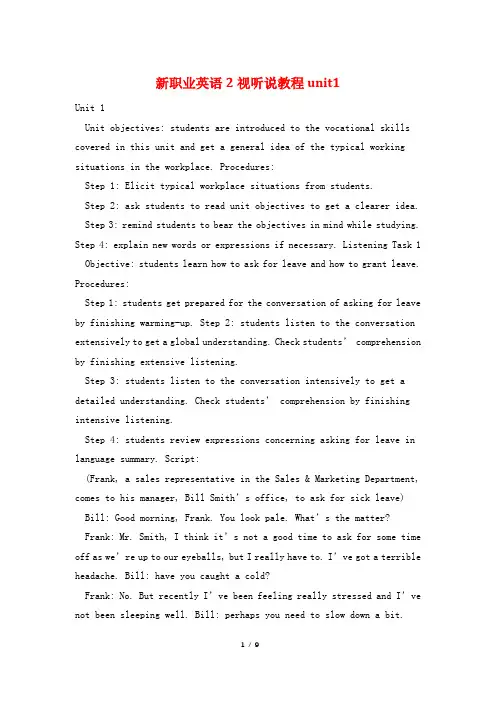
新职业英语2视听说教程unit1Unit 1Unit objectives: students are introduced to the vocational skills covered in this unit and get a general idea of the typical working situations in the workplace. Procedures:Step 1: Elicit typical workplace situations from students.Step 2: ask students to read unit objectives to get a clearer idea. Step 3: remind students to bear the objectives in mind while studying. Step 4: explain new words or expressions if necessary. Listening Task 1 Objective: students learn how to ask for leave and how to grant leave. Procedures:Step 1: students get prepared for the conversation of asking for leave by finishing warming-up. Step 2: students listen to the conversation extensively to get a global understanding. Check students’ comprehension by finishing extensive listening.Step 3: students listen to the conversation intensively to get a detailed understanding. Check students’ comprehension by finishing intensive listening.Step 4: students review expressions concerning asking for leave in language summary. Script:(Frank, a sales representative in the Sales & Marketing Department, comes to his manager, Bill Smith’s office, to ask for sick leave)Bill: Good morning, Frank. You look pale. What’s the matter?Frank: Mr. Smith, I think it’s not a good time to ask for some time off as we’re up to our eyeballs, but I really have to. I’ve got a terrible headache. Bill: have you caught a cold?Frank: No. But recently I’ve been feeling really stressed and I’ve not been sleeping well. Bill: perhaps you need to slow down a bit.Frank: That’s the reason why I’ve come to ask for leave. And on top of it all, my mother had a heart attack yesterday. She’s in hospital. Bill: I’m really sorry to hear that.Frank: I really need some personal time to spend with my mother. Could I have a week off?Bill: That’s going to be difficult as we’re so understaffed at the moment…But Frank, family comes first, so take some time off. All I ask is: could you please submit a detailed progress report before you go? Frank: Yes, of course. I can get that done this afternoon. By this way, Lisa has offered to do some work on my project while I’m away. And I’ll get back as soon as possible.Bill: Good, thanks for that. Give my best wishes to your mother. I hope she gets better soon. Frank: thank you. Key:1. warming upfatigue concentration trouble muscle trouble headaches stomach problems restless sleep2. extensive listening 1. his headache 2. his stress3. his bad sleep4. his heart disease5. his sick mother 3. intensive listening C B B Task 2 Team CooperationObjective: students can talk about team building and cooperation in the workplace. Procedures:Step 1: students get prepared for the conversation of asking for leave by finishing warming-up. Step 2: students listen to the conversation extensively to get a global understanding. Check students’ comprehension by finishing extensive watching.Step 3: students listen to the conversation intensively to get a detailed understanding. Check students’ comprehension by finishing intensive watching. Script:(Bill goes to the project team to encourage them and to see if he can offer some help) Bill: I’ve heard that some team members have been complaining. Jenny: It’s because we’ve been under great pressure recently.John: Our marketing plan was turned down again yesterday. I feel very frustrated. Bill: Well, frustration is not terrible. What’s terrible is to expect failure.John: What makes me despair is that Frank is not here. If he were here, we’d probably have managed to work out effective marketing strategies that would have been accepted.Bill: Well, Lisa can help you. She’s taken over Frank’s work and will work with you on the strategy.Lisa: I will do my best to help. In my opinion, if the work is difficult, it’s better to use all the strengths of the team. We can bring all our abilities and wisdom into full play.John: Yeah, well, that sounds right. Maybe I have to learn to manage myself better. I have to realize the importance of cooperation.Bill: Cooperation is most important for us all. Well, is there anything else I can do for your team, Jenny?Jenny: No. Thanks. We’ll probably encounter some more difficulties, but together we can get through them and achieve our goals.Bill: Wonderful. I’m happy to see that you have self-confidence and the spirit of cooperation. Jenny: Thanks very much. Key:2. extensive watchingJohn has taken Frank’s place to help the team work on the marketing strategies Lisa feels disappointed because of experiencing difficulties in the work again 3. intensive watchinga. False …some team members have been complainingb. True If he were here, we’d probably have managed to work out effectively marketingstrategies…c. False Maybe I have to manage myself better. Task 3 SpeakingObjective: This part aims at guiding students to practice the skills they’ve learned in listening andwatching. Students achieve communication skills in asking for leave, building mutual trust and team cooperation.Procedures:Step 1: explain the task and lead students through the sentence given. Step 2: put students into pairs and ask them to think of as many expressions or sentences aspossible about asking for and granting leave of absence.Step 3: ask students to take turns to read aloud the sentences. Circulate to provide help ifnecessary.Step 4: call on volunteers or selected pairs to make a presentation to the class. Sample:…have a week off work…my father had a stroke due to high blood pressure. …take a half-day off…I need to go for a health checkup. Unit 2Unit objectives: students are introduced to the vocational skills covered in this unit and get ageneral idea of the typical situations encountered when preparing for and having meetings.Procedures:Step 1: elicit typical working situations for preparing for and having meetings from students. Step 2: ask students to read unit objectives to get a clearer idea.Step 3: remind students to bear the objectives in mind while studying. Step 4: explain new words or expressions if necessary. Task 1 Reason for a MeetingObjective: students can give reasons for or against having a meeting. Procedures:Step 1: students get prepared for the conversation concerning reasons for a meeting by finishingwarming up.Step 2: students listen to the conversation extensively to get a global understanding. Checkstudents’ comprehension by finishing extensive listening.Step 3: students listen to the conversation intensively to get a detailed understanding. Checkstudents’ comprehension by finishing intensive listening.Step 4: students review expressions for future plans and intentions in language summary. Script:(In the CEO’s office, Bruce is talking to Bill about the sales for the first half of this year.)Bruce: Bill, I’ve been reading the sales report you gave me the other day. I see our sales have beendecreasing since the last quarter. What’s happened?Bill: That’s what I want to talk to you about. There are lots of reasons, but primarily, wee think it’sbecause we don’t have enough new products to meet market demands. Bruce: That can’t be right. We’ve a lot of new products.Bill: Still not enough. According to our research, the market is changing much faster than weexpected. So are our competitors.Bruce: Then I think we need to have a meeting to discuss the problem and work out whatmeasures to take.Bill: That would be great.Bruce: I’ll ask the Production and the R & D Departments to join the meetings as well. And I needyou to contact all the sales representatives and ask them to attend the meeting.Bill: No problem. When do you want to have it?Bruce: How about next week? You contact all the sales representatives and set a time. Next weekI’m available every day except Monday and Wednesday.Bill: OK, I’ll let you know when we set the time and I’ll copy you in on the agenda. Key:1. Warming up.Like You can exchange ideas and opinions during meetings. Dislike Meetings can be time-consuming.Sometimes people might discuss things that they don’t care about. 2. extensive listeninga. False I see our sales have been decreasing since the last quarter. What’s happened?b. False Then I think we need to have a meeting to discuss the problem and work out whatmeasures to take.3. Intensive listening B A BTask 2 watchingObjective: students learn how to take meeting minutes. Procedures:Step 1: students get prepared for the video clip about minutes taking by finishing warming up. Step 2: students watch the video clip extensively to get a global understanding. Check students’comprehension by finishing extensive watching.Step 3: students listen to the conversation intensively to get a detailed understanding. Checkstudents’ comprehension by finishing intensive watching.Step 4: students review the usage of model verbs in language summary. Script:(Lisa is talking with Eric. She wants to seek some advice from Eric on taking Minutes.) Lisa: Hi, Eric, how’s it going?Eric: Just a bit busy. We have a meeting next Monday, so I’ve got a lot of preparation to do.Lisa: Oh, the regular meeting? I need to take minutes for an important meeting next Thursday. Butto be honest, I’m not really good at it. Would you please give me some tips?Eric: I’d be happy to. Look, here are some meeting minutes.Lisa: Wow, they look good. They’re very well organized and laid out and the contents seem verylogical.Eric: Thank you. To take good minutes, you really need to concentrate. Of course, you must beaccurate as well. Make sure you have the name of the company and the meeting, the date, time, and venue correct and the names of all the people present. Make a note of the exact time that the meeting is opened and closed and who is in the chair.Lisa: is that all?Eric: No. That’s the easy part. Lisa: Then what else should I do?Eric: During the meeting you have to take notes of all the topics discussed, the main points madeby each speaker and any decisions made. Then after the meeting, you must type up your notes and circulate them to everyone who attended the meeting. Lisa: But the problem is I can’t take down everything everyone says during the meeting.Eric: You don’t have write down every word. You just make a not of the main points about eachtopic, such as the business transacted, the resolutions passed and the decisions reached at a meeting.Lisa: Oh, I see. Thank you very much! Eric: Don’t mention it. Good luck! Key:1. warming upa. Minutes: the record of a meetingb. Agenda: the items to be discussed at a formal meetingc. Schedule: timetable for a project or a program 2. extensive watchinga. False …I’m not really good at it. Would you please give me some tips?b. False Then after the meeting, you must type up your notes and circulate them to everyonewho attended the meeting. 3. intensive watchinga. concentrateb. accuratec. the name of the companyd. opened and closede. take notes off. decisionsg. type upTask 3 SpeakingObjective: This part aims at guiding students to practice the skills they’ve learned in Listening & Watching. The task is designed to help students achieve communication skills in typical situations related to business meetings. Procedures:Step 1: explain the task and give students time to look through the uncompleted conversation. Step 2: put students into pairs to complete the conversation. Circulate to provide help if necessary. Step 3. call on volunteers or selected pairs to role-play the conversation to the class. Key: 1. B 2. C 3.A 4. DUnit 3Unit objectives: students are introduced to the vocational skills covered in this unit and get ageneral idea of the typical working situations concerned with business travel.Procedures:Step 1: elicit typical working situations for preparing for and having meetings from students. Step 2: ask students to read unit objectives to get a clearer idea.Step 3: remind students to bear the objectives in mind while studying. Step 4: explain new words or expressions if necessary. Task 1 Listening Booking a TicketObjective: students learn how to book a ticket for a business trip. Procedures:Step 1: students get prepared for the conversation concerning booking a ticket by finishing。
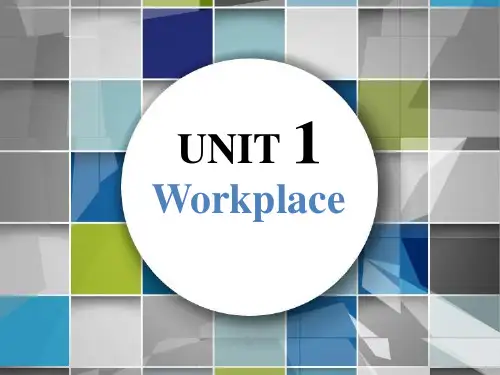
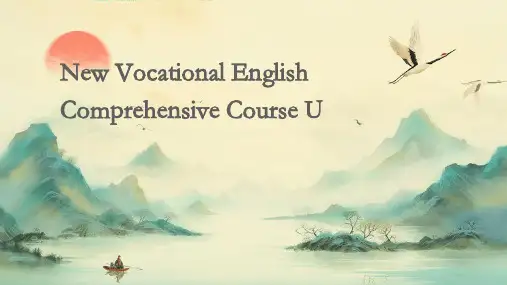
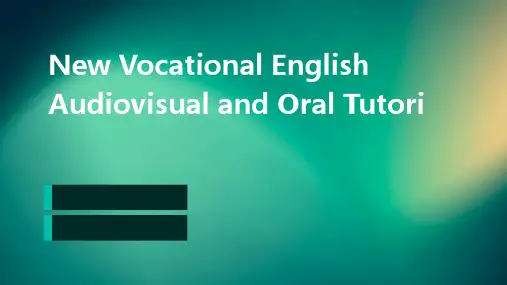
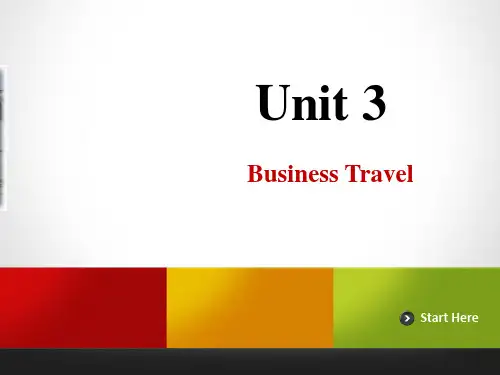


周次:第 周 课次:第 次 授课时间: 年 月 日 Unit 1 Organization 教学目标 Students are introduced to the vocational skills covered in this unit and get a general idea of the typical working situations in a company. After studying this unit, students should be able to: Ask about and describe a company Describe and explain a company structure 教学重点、难点 重点:Unit File,New Words and Expressions; extensive listening, language summary,intensive listening 难点:Intensive listening, Intensive watching, Extensive listening, Extensive watching 课时安排: 2 periods 教学方法 1. Discussing, listening by the students; 2. Explanation and demonstration by the teacher. 教具 Multimedia, blackboard 教学内容和步骤 Listening 1 Task1 Company Description Objective: Ss can understand a description of a company. Procedures: • Step1: Ss get prepared for the conversation of company description by finishing Warming-up. • Step2: Ss listen to the conversation extensively to get a global understanding. Check Ss’ comprehension by finishing Extensive Listening • Step3: Ss listen to the conversation intensively to get a detailed understanding. Check Ss’ comprehension by finishing Intensive Listening Step4: Ss review expressions concerning company description in Language Summary Task 2 Company Structure Objective: Ss can understand a description and explanation of a company structure Procedures: • Step1: Ss complete the crossword puzzle to form words that relate to departments in a company. Provide more related words. • Step2: Ss listen to a speech by Anna Brooks and tick the correct answer to each question • Step3: Ss listen to the conversation again and complete the organizational structure of the company. Watching 1 Task 1 Company Description Objective: Ss can learn the skills of asking about and describing a company Procedures: • Step1: Warming-up Suppose you come across an old friend you’ve not seen for some time. How do you greet each other? • Step2: Ss watch a video clip and match the names with the related information. • Step3: Ss watch a video clip again and complete the form.. • Step4: Ss review the sentences describing a company in Language Summary. 课后作业: Finish the corresponding exercise 课后小结:
周次:第 周 课次:第 次 授课时间: 年 月 日 Unit 1 Organization 教学目标 Students are introduced to the vocational skills covered in this unit and get a general idea of the typical working situations in a company. After studying this unit, students should be able to: Ask about and describe a job and its responsibilities Understand and explain a company’s operation 教学重点、难点 重点:Warm-up activity, Language summary, Intensive watching, Extensive watching 难点:Intensive watching, Extensive watching, Speaking 课时安排: 2 periods 教学方法 3. Discussing, listening, reading, presenting, and role-playing by the students; 4. Explanation and demonstration by the teacher. 教具 Multimedia, blackboard 教学内容和步骤 Watcing1 Task 2 Company Structure Objective: Ss can learn the skills of describing and explaining a company structure. • Step1: Warming-up Suppose you have got a part time job. How would you greet your manager on your first day at work? • Step2: Ss watch a video clip and tick those that are covered in the talk. • Step3: Ss watch a video clip again and answer the related questions.. • Step4: Ss compare the words and expressions in Language Summary.
Speaking 1 Objective: This part aims at guiding Ss to practice the skills they’ve learned in Listening1 and Watching 1. • Step1: Ss work in pairs. Complete and practice conversation. • Step2: Ss work in pairs. Role-play a conversation. • Step3: Ss work in pairs. Make sentences with the help of the tips. • Step4: Ss work in pairs. Suppose they work in the HR Department of a company. Practice introducing your company organization to a new staff member.
Listening 2 Task1 Job Duty Objective: Ss can understand a description of a job and its responsibilities. Procedures: • Step1: Ss learn some abbreviations for some positions by finishing Warming-up. • Step2: Ss listen and match the responsibilities in the right column with the person in the left column according to the conversation. • Step3: Ss listen to the conversation intensively and fill in the blanks with proper words. Step4: Ss fill in the blanks with proper words. 课后作业: Finish the corresponding exercise 课后小结: